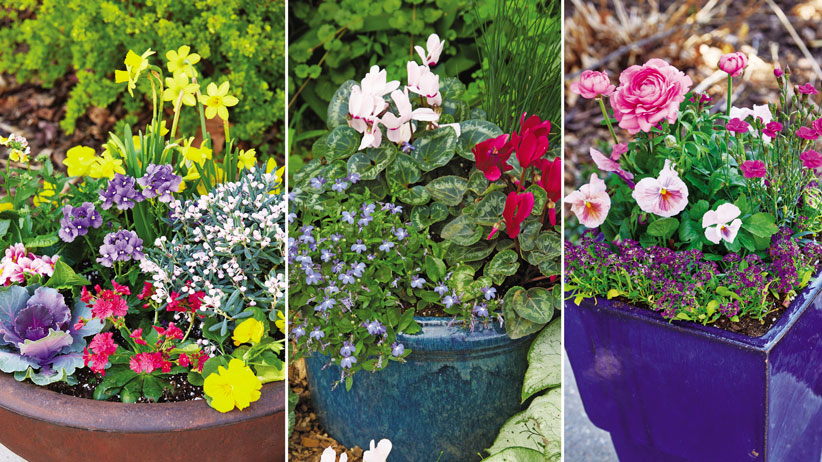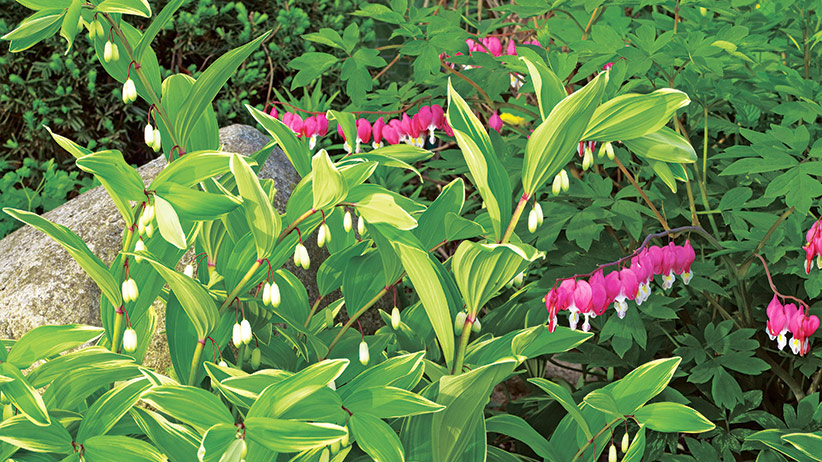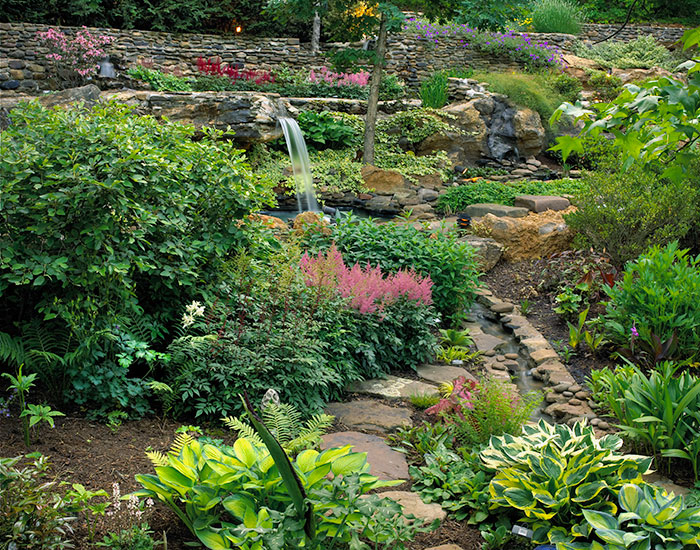
Don't give up on shade with these shade garden design tips
Struggling to figure out how to garden in shady spots? Not to worry. Shade offers the opportunity to grow wonderful plants that not only tolerate a lack of sunlight but thrive there. Here are some great ideas from Sandi Burdick and Tom Boyd of Tennessee who turned a shade-filled yard into a peaceful retreat they can enjoy year-round.
This shady USDA zone 7 hillside has a steep slope that ends in a big ravine and was covered with brush and poison ivy. At roughly 120 by 140 feet it's a pretty big yard, but you can adapt Sandi and Tom's shade garden design tips and ideas to any size garden.
You Might Also Like:
Beautiful Stone Raised Garden Beds
Different Types of Ferns
DIY Privacy Screen
Add stone and water
One of the great things about shade is that it keeps you cool even on hot days. The sound of flowing water and cool stone pavers to walk on adds to the cool and relaxing feel of this quiet shade garden.
Sandi and Tom started the cleanup of this overgrown hillside by having it graded to make it more stable. During the process they uncovered large boulders and lots of smaller rocks just under the soil's surface. Rather than dispose of them, they set them aside to use later in the paths and water feature you see in the photo above.
Three of the largest boulders were tucked back into the hillside to create the waterfall. A small stream winds through the garden to a pond lower down the slope. To save water, it's then recirculated back up the slope to a pond above the waterfall. If you don’t have room for a large water feature, a small pond or container with a fountain works just as well. Plus, you’ll be amazed at the birds that flock to moving water in both summer and winter.
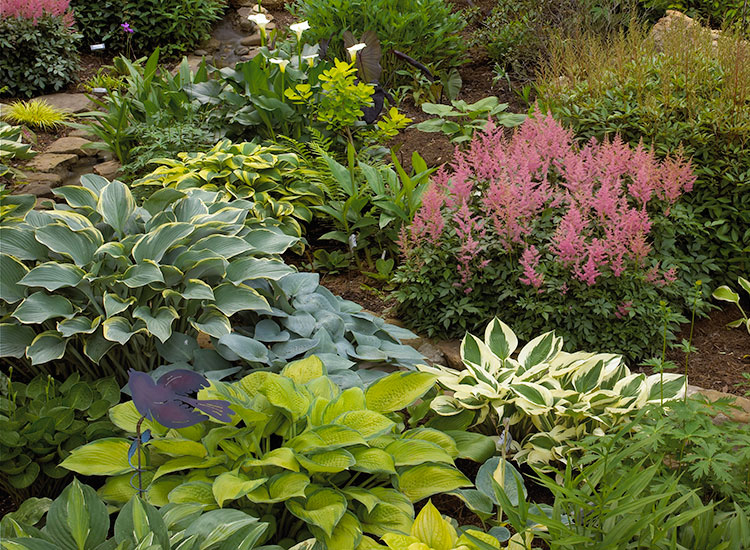
Group colorful plants together
Large groups of plants are great in a big shade garden because it gives bold impact. Astilbes (Astilbe spp. and hybrids), such as those above, are planted in clumps of three to five each throughout the garden. If there was just one plant positioned here and there even these bright plumes would get lost in the view. Another great thing about gardening in shade — the flowers last longer without harsh sun beating down on them.
Most of the plantings are low, especially in the center area. Sure, there are large trees overhead, but by keeping the shrubs and perennials short, you have lots of unobstructed views of the entire space. If you’ve ever visited a woodland glade, you’ll notice that this hillside garden has a similar feeling, even though it’s manmade.
Repeat shade plants for unity
Repetition is a design tip that can tie any size garden together. You don't need to repeat everything, just a few striking plants are enough. You'll find several themes repeated in this garden:
- Native stone found during clean-up was used to build the paths and walls which provide a strong connection through the entire garden.
- Bright pink astilbe plumes lead your eye through the beds in late spring to summer. You can even leave the dried flowers in place into fall, though they won't be as eye-catching.
- Hostas (Hosta spp. and hybrids) with a similar leaf shape but varied colors and patterns keep the look cohesive.
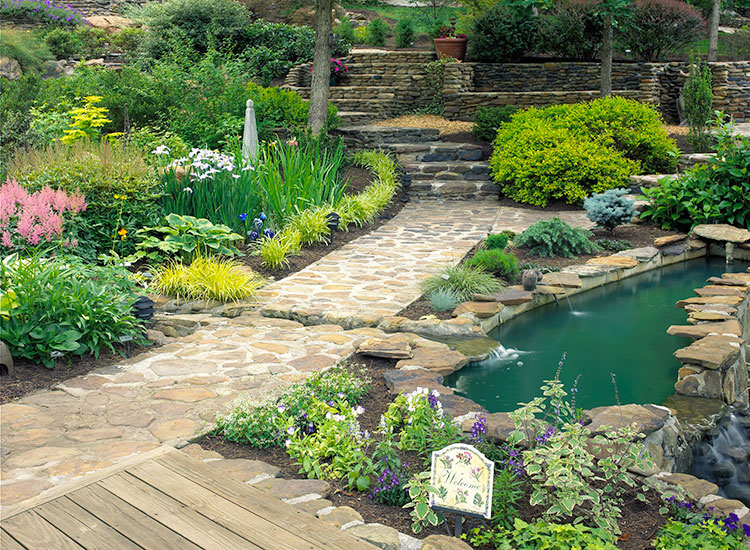
Add shady paths
Getting from one area to another wasn’t always easy on this hillside — walking up the steep incline was quite a challenge! So after laying out and leveling the areas where the paths would be, Sandi and Tom used the stone that was excavated earlier to build paths and steps. They're set in mortar to ensure stable footing from the lowest part of the garden up the hillside.
It's easy for stone to get slippery, especially in shade. To avoid a stumble, you can scatter sand to help with traction or use an outdoor nonslip sealant.
One challenge Sandi and Tom faced when they installed the paths was how to cross the long winding stream between the pond and the waterfall. A small bridge would work but instead they came up with this creative solution: A narrow cut in the paver that crosses the stream allows water to flow through the path. All it takes is a small step over the stream to continue on your way. Or stop and dip your toes in the cool water on a hot summer day.
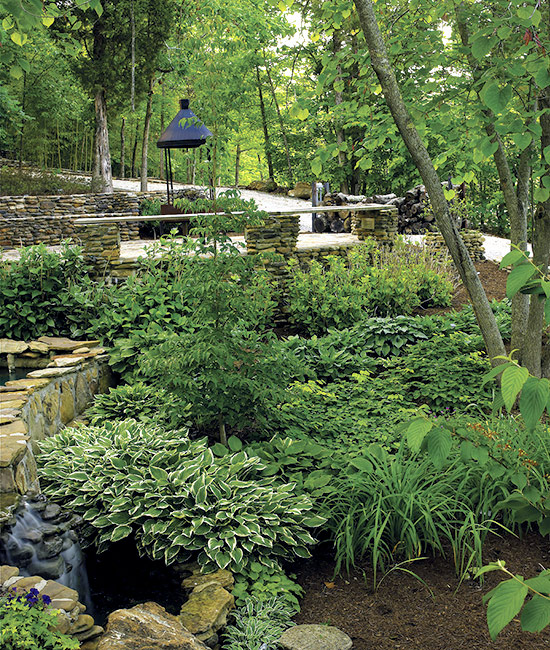
Plan for shade garden gathering spots
Shade is the perfect place to gather with family and friends. Up the hill you'll find the large level area in the photo above that has enough space for small groups. Setting it high like this gives visitors a great view of the entire garden. The bench that goes around the edge provides a spot to sit and relax and also creates an unobtrusive railing to prevent a misstep.

Choose soothing colors for shade
Sandi wanted a calming color palette for her peaceful retreat, so she used muted shades of pink and blue with splashes of white. A few touches of bright yellow and chartreuse, such as the hostas (Hosta spp. and hybrids) here, add a little zip to the color scheme so it’s restful but not boring.
With the added shelter of the tree canopy, shade gardens can get pretty dark at night. So if you spend evenings in your garden, a pastel color scheme like this will help brighten it up and seem to illuminate the area. And if solar lights won't work, plant pale-colored or white flowers near a path to help guide you after the sun sets.
You Might Also Like:
Tomato Plant Problems
How to Stake a New Tree
Marvelous moss garden
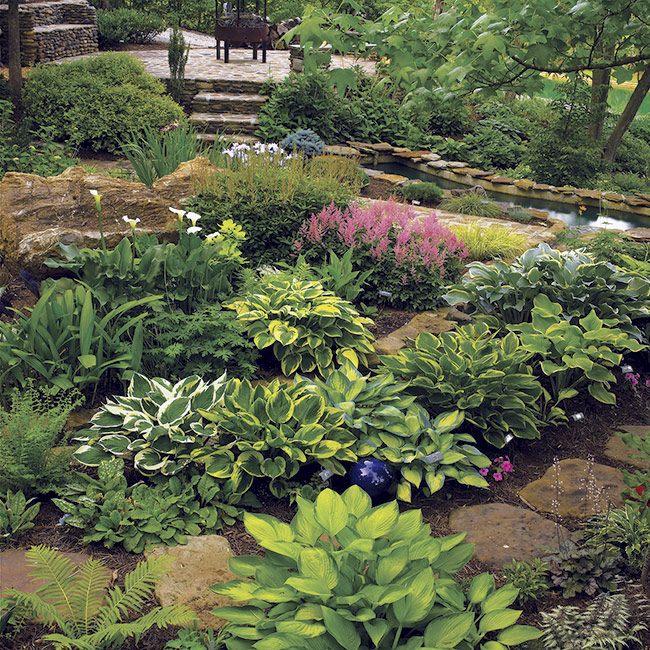
Put shade plants in the right spot
In every garden you'll find a variety of growing conditions and shade gardens are no exception. At Sandi and Tom's place, the hillside is dry, yet the level bottom is moist, even wet at times. Plus, after grading, there were pockets of good soil, as well as areas that weren't. So they brought in more soil and lots of compost to fill planting areas, especially between the stones. With a goal of having color all year round, it took some doing but they finally found just the right mix of plants to fit the different growing conditions. Here are a few tips Sandi and Tom have used to fill their shady yard with color and texture:
- Choose vigorous perennials that spread on their own (but not too aggressively) so they form a large group. That’s important in a big garden, especially if you’re working with a budget. Buy a few plants and let them grow together. You can also lift and divide them occasionally to spread them around.
- Don't forget trees and shrubs for shade Even in shaded areas Japanese maples (Acer palmatum) and dogwoods (Cornus spp. and hybrids) will turn orange and red. And a few shade-loving dwarf conifers, mixed with the textured bark of paperbark maple (Acer griseum) , will keep any garden from looking lifeless in winter.
- Tuck in a few tropical plants or put your houseplant outdoors for summer to get a burst of summer texture and foliage color. Many tolerate the shade.
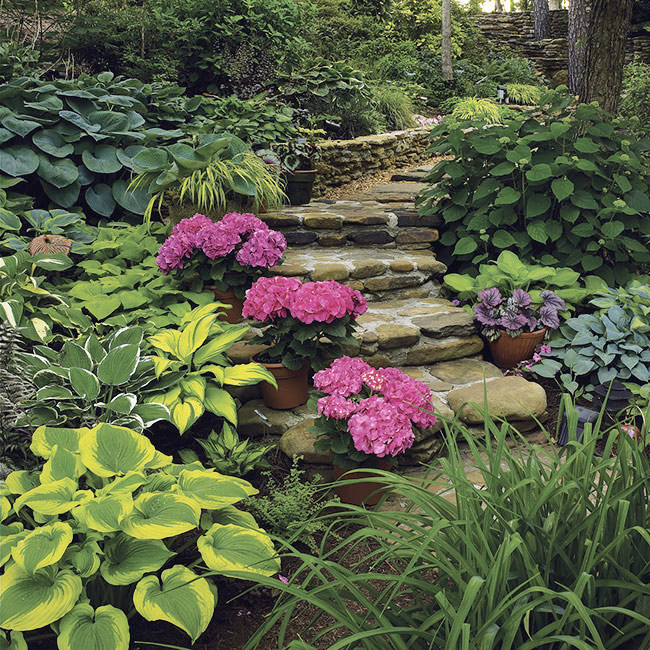
- Add quick color with potted plants. They’re especially handy to highlight areas like the steps above. Guests will spot these long-lasting bright pink hydrangeas and can easily locate and navigate the steps. When the flowers fade, you can swap them with something new.
As you’ve seen, gardening in shade has real possibilities. Big or small, you can use these design tips in any moist or dry shady garden to create your own cool and relaxing hideaway.








